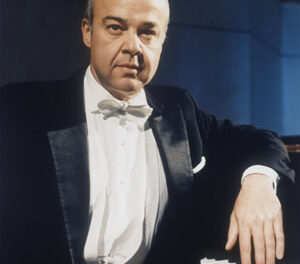WINSTON-SALEM, NC – The Winston-Salem Symphony welcomed legendary double bassist Edgar Meyer in Saturday Night’s performance of the cleverly named concert “Edgar Meyer + The New World.” Meyer, born in Oak Ridge, TN, is known both in the bluegrass and classical world; he has been nominated seven times for Grammy Awards and taken home five. W-SS Music Director Michelle Merrill confidently led the forces through a wonderful collection of American and European music.
Warming up the crowd was the short Strum by Jessie Montgomery (U.S., b. 1981). Originally conceived in 2006 as a string quintet, the current string arrangement was completed in 2012. As she explains in the program notes, using “American folk idioms and the spirit of dance and movement, the piece has a kind of narrative that begins with fleeting nostalgia and transforms into ecstatic celebration.”
The opening begins with plucked strings, reminding one of banjo music (the instruments were held like banjos, not under the chin), and the music takes the listener through joyous dance music with some nostalgic wisps and ends with joyous abandon – a perfect opening to what followed, which was Meyer’s own Concerto No. 1 (1993) with the composer as soloist on double bass.
This work clearly uses elements from the “old” and “new world.” For example, the work is in the traditional classical concerto structure of three movements: fast-slow-fast (here titled “Opening, Middle, Finale.”) The idea of unaccompanied flights of fancy (of which there were plenty) featuring the solo instrument sounded like improvisation (old school: cadenza).
In the opening, one could hear folk-like strands of melody from the soloist with short staccato responses from the strings before the two support each other in lyric trade-offs. The action quickens and the meter changes constantly, providing lots of bounce and unanticipated accentuations; Maestra Merrill negotiated these rapid changes without problems. The gentler opening returns at the end.
The second movement begins with a soulful melody accompanied by pizzicato strings. A more frenzied middle section appears before the opening returns. The finale is a hoedown, with virtuosity for the soloist at the forefront. The action slows for some low growls from the double bass, before the tempo picks back up to a spectacular dash to the finish. The audience was fittingly awestruck by both the composition and the performance.
Meyer returned to the stage to play a 19th century concerto by Giovanni Bottesini (Italy, 1821-1889), “the Paganini of the double bass.” The composer’s Concerto No. 2 in B minor “is one of his most performed solo works for the bass” and is in the traditional three movements. The audiences of the day were probably wowed, but after Meyer’s Concerto, the work was a bit less impressive.
Not that Meyer’s playing was not spectacular, because it was – he even played his own original cadenzas. But it seemed a bit “old school” after the late 20th century Meyer work. Plenty of lyricism resides in the first movement, but it also explores some of the extreme registers of the instrument. The middle movement is an aria, poignant and beautiful, but also full of passion. The finale begins with a fiery orchestral introduction before the soloist takes up an animated tune. A long cadenza once again displayed Meyer’s superb technique and musicality.
The second half of the concert featured one of the most popular works in the literature, Symphony No. 9 in E minor “From the New World” (1893) by Antonín Dvořák (Bohemia – now Czech Republic, 1841-1904). It was written in the United Sates, where Dvořák was living at the time. The composer was an advocate for the music of Native Americans and African Americans, and in this symphony, which draws on “real” American music (“new world”), he shows how it could be done. Another wonderful element of the work is that motives presented in each movement return later in the work.
After a slow introduction, the main theme, an ascending E minor triad is announced by the horns; one will hear this several times in the course of the work. A dance tune is heard next, followed by a tune reminiscent of “Swing Low, Sweet Chariot.” Merrill really slowed the tempo down for this presentation, helping to provide contrast as well as adding a distinctive touch.
The slow second movement, which opens with a chorale magnificently played by the brass, contains the most famous tune, the lyrical “Goin’ Home,” evocatively played on English horn (by a musician not identified in the program). The conductor used contrasting dynamics to maximum effect here. The third movement, a scherzo, is a romp and conjures up (at least to this listener) the greatest of Western films. The finale features blaring brass as well as a return of almost every tune heard earlier.
The playing by the W-SS was, by turns heroic, gentle, and flowing, lyric and bombastic. Dvořák would have been pleased. The entire evening really was about the “new world” epitomized by Montgomery, Meyer, and yes, Dvořák, as contrasted to the “old” world of Bottesini (and Dvořák?). Bravo to all!













